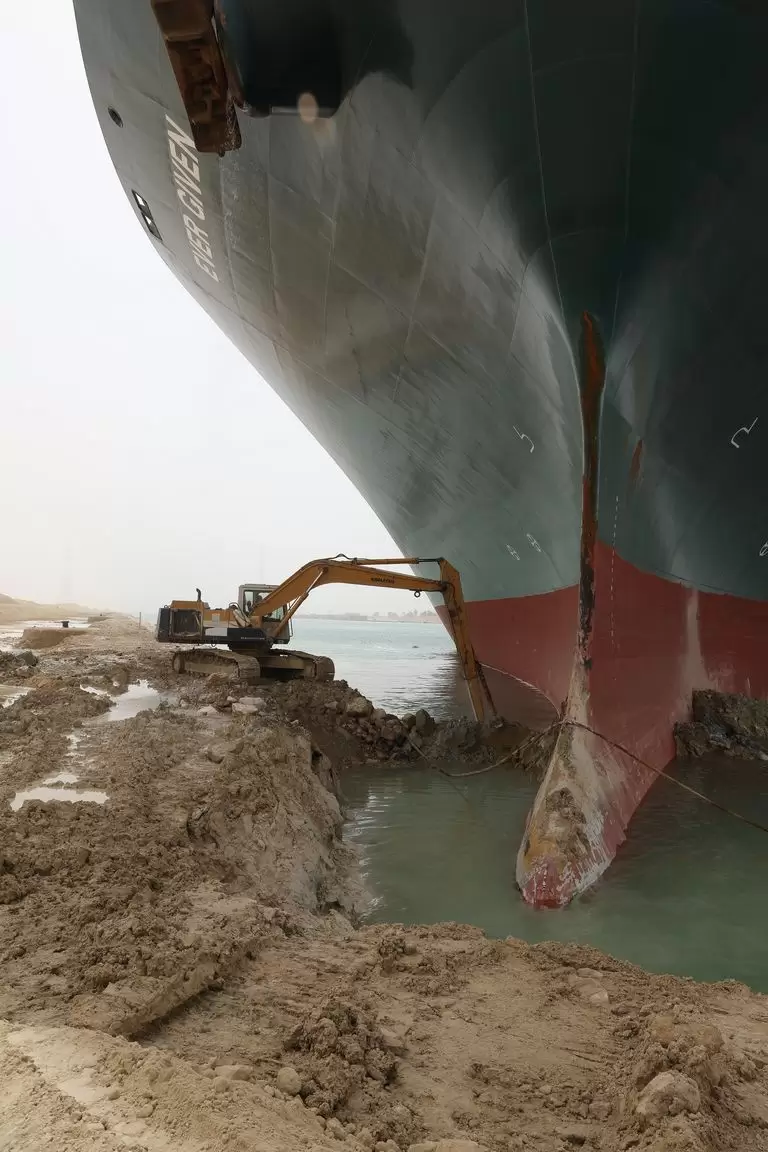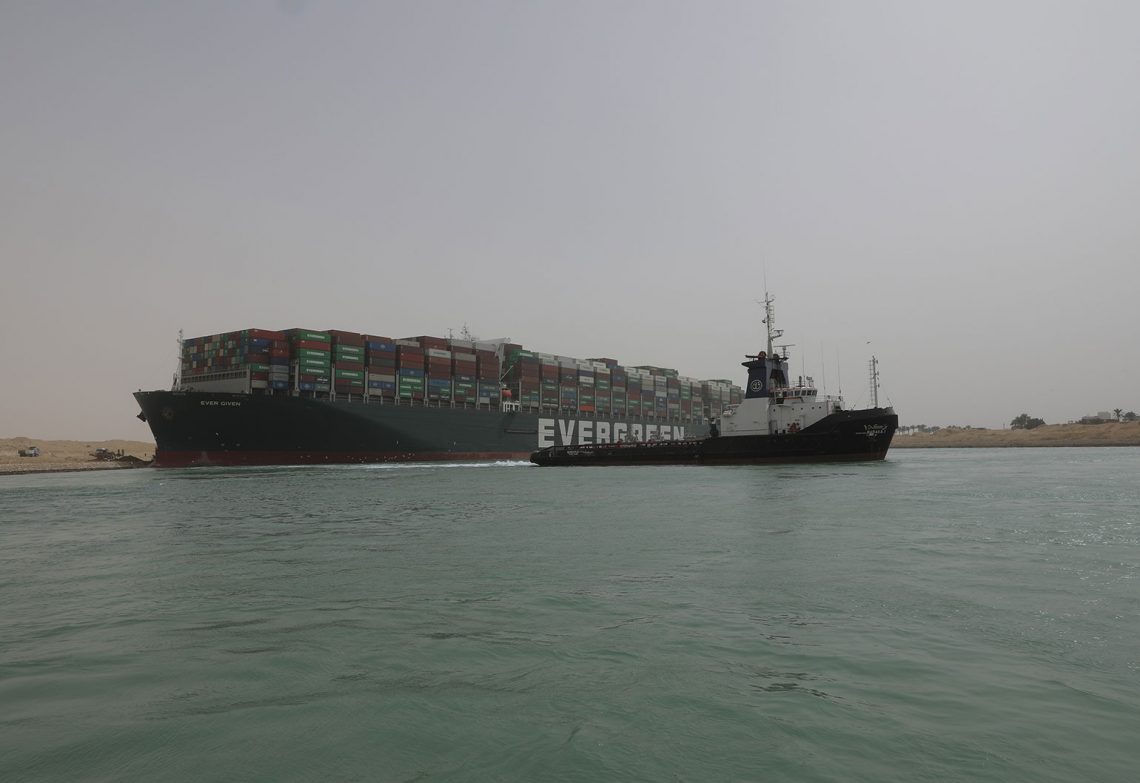The giant container ship Ever Given was successfully refloated almost a week after it became lodged in Egypt’s Suez Canal and disrupted the global shipping industry. Here’s how it happened.
The 400-metre-long ship — for comparison, the Eiffel Tower is just 324 m tall — became stuck in the mud and sand at the southern end of the canal this past Tuesday 23 March.
It blocked one of the world’s busiest trade routes, ultimately preventing more than 300 vessels, including container ships and bulk carriers, from passing through the canal, which connects the Mediterranean and Red seas.
Operated by Taiwanese shipping company Evergreen Marine Corp. under a Panamanian flag, the 200,000 t vessel was on its way to Rotterdam in the Netherlands from the Yantian district in China.
How did it get stuck?
The Ever Given was carrying 18,000 containers when it became jammed diagonally across a southern section of the canal early on 23 March. Initial reports blamed a sandstorm and strong winds for the blockage, with a recorded wind speed at the time of 40 knots.
Writing for The Conversation, Professor of Maritime Fluid Dynamics at the University of Southampton Stephen Turnock said the ship’s containers, stacked high on the deck, were suspected to have caught a gust of wind like a sailboat’s sail.
“It appears that the Ever Given lost control while heading northbound along the Suez Canal, diverting its course in such a way that one end struck one of the canal’s banks,” he wrote.
“The momentum of the massive vessel will then have pulled it round until the other end struck the other bank — slowly, perhaps, but with a huge amount of force.”
But the Chairman of the Suez Canal Authority (SCA) Osama Rabie offered an alternative version of events.
“Weather factors were not the main reasons for the ship’s grounding,” he said on Saturday, explaining “technical or human errors” may have played a role in the accident.
An investigation into how the ship ran aground is now underway.
The Ever Given is one of the world’s largest container ships, and Captain Morgan McManus from SUNY Maritime College said the push to build increasingly large vessels could be partly to blame for the incident.
“The scale has gotten so big that a lot of the infrastructure has yet to catch up with the size of the ship,” he told Popular Mechanics.
Adverse weather conditions only added to the challenge of steering such a large vessel.
A complex operation
Initial attempts to dislodge the ship included using a digger to excavate the bow while tugboats worked to pull and push the vessel free.
But after two days of no movement, Dutch firm Smit Salvage, owned by Boskalis, was called in, along with Japanese firm Nippon Salvage.
Smit represents the “special forces” of salvage teams, according to American maritime historian Sal Mercogliano.
Moving the Ever Given was a complex operation, Mercogliano said, with “the bow basically in Asia, the stern in Africa, and the middle in the middle of the canal”.
“What you can’t do is take a lot of weight off the ends and put a lot of what [is called] ‘sagging stress’ on the vessel,” he said.
“You could conceivably crack the hull, cause an oil spill. [Or] worse, catastrophically fracture the vessel in half, which would close the canal for months, if not years.”

There are two basic approaches to refloating a grounded ship, according to Turnock.
“First, salvage crews will work to increase the vessel’s vertical buoyancy force, which means the whole boat floats higher in the water,” he said.
“Second, tug boats will apply sufficient horizontal force to overcome the static friction generated by whatever material the boat is resting upon. The larger and heavier the vessel, the more force required by the tug boats to refloat the ship.”
With the initial attempts using tug boats failing, dredgers were brought in to dig mud and sand from under the bow and stern of the ship. These are a familiar sight on the Suez Canal, according to Mercogliano, and are used to ensure the waterway remains navigable.
On 26 March, Evergreen Marine announced the plan was to “continue the ongoing efforts to clear sand and mud around the ship’s bow and try to free the vessel at high tide”.
An additional specialist ‘suction dredger’ was brought in, which was able to move 2000 cubic metres of material every hour.
By Sunday 28 March, five days after the Ever Given got stuck, the dredging operation had removed more than 18,000 tonnes of sand and mud from under the ship. This helped loosen the bow and clear the ship’s stern from the sand bank.
But a high tide had failed to float the ship as expected.
“The rudder and propeller of the vessel are fully functional and expected to provide additional support to tug boats assigned to move the container ship from the accident site so that normal transit may again resume within the canal,” Evergreen Marine reported at the time.
Attempts to free the vessel continued, and on Monday, Rabie from the SCA announced the ship had been successfully refloated.
“This was the result of successful push and tow manoeuvres, which led to the restoration of 80 per cent of the vessel’s direction, with the stern 102 m away from the bank of the Canal now, instead of 4 m prior to the refloating,” the SCA said in a statement.
About 30,000 cubic meters of sand was dredged and a total of 11 harbour tugs and two powerful seagoing tugs were used to pull the ship free during a higher tide.
From there, it was directed to the Bitter Lakes waiting area, where it will undergo technical inspection.
It was important for salvage teams to understand the precise way the Ever Given had struck ground, Turnock said, because, as with extracting a splinter, it is usually easiest to refloat a grounded ship the way it went in.
If the operation had failed, buoyancy air bags could have been attached to the underwater section of the hull to encourage it to float.
“But in the case of the Ever Given, this [would] need to happen alongside the unloading of the ship’s cargo, the removing of all on-board ballast water, and the draining of the ship’s fuel, all in an effort to make the vessel lighter and more buoyant before the tugs attempt another horizontal pull,” Turnock said.
This is not the first time a ship has become grounded in the Suez Canal, but it is one of the more complex. Peter Berdowski, CEO of Boskalis, said it had required a team effort to ultimately free the Ever Given.
“I’m extremely proud of the outstanding job done by the team on site as well as the many Smit Salvage and Boskalis colleagues back home to complete this challenging operation under the watchful eye of the world,” he said.
“The time pressure to complete this operation was evident and unprecedented and the result is a true display of our unique capabilities as a dredging and marine services provider.”




I wonder what “at high tide” means. I have brought ships through Suez Canal many times before and there is hardly any tidal range in the canal, at least, not on a daily basis. Over the 5 days the ship was grounded there, what was the tidal range like? Did anybody make any observation or calculation? I would say the “high tide” did very little to help the ship to refloat, not worthy of mentioning.
Job best done. Congrats to the salvage teams.
What a remarkable feat by all involved, great job done by all.
Yes I do agree with the writer and explanation from this giant container ship 400 long and 60 meter beam.I do call this a floating island .a very obstruction wall with 18.000 containers on board what a windjammer and force on the ship . wind force problem.same as car carriers they are a balloon on the water.when they are empty.my opinion is have channels between rows off container.I know is a cost of lesser containers on board..or permanent position bow trusthers so soon wind increasing automatic trusthers start pushing ship back on course and position.other wise give more space to the sues canal ponds we do give space back to the river .or more dredging we have very nice and powerful dredging equipment in the Netherland only peanuts comparing to the cost of 10 days delay and litigation cost .we done plenty work since the 1950 in the sues canal..I love to help just call us and we are come to the rescue .or one advice don’t make the ships to big become a blowing out embrella effect .or go around the cape only 10 days longer kkuiper@ozemail.com.au.